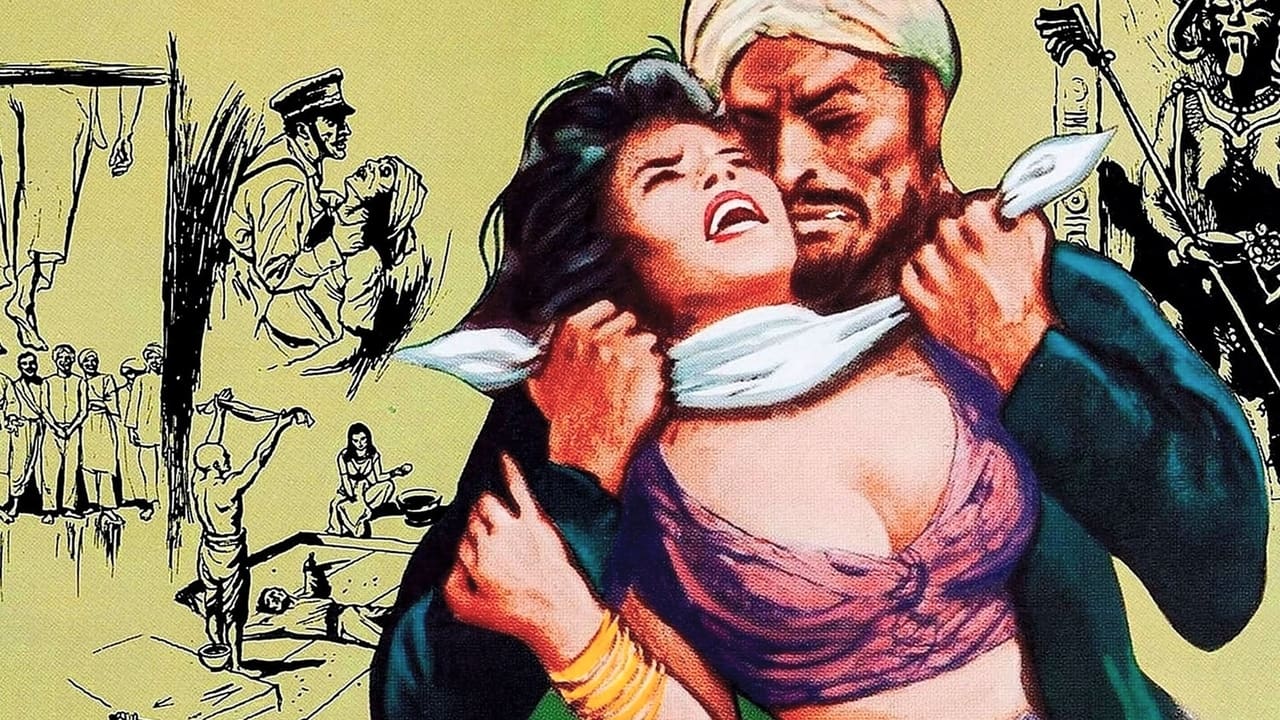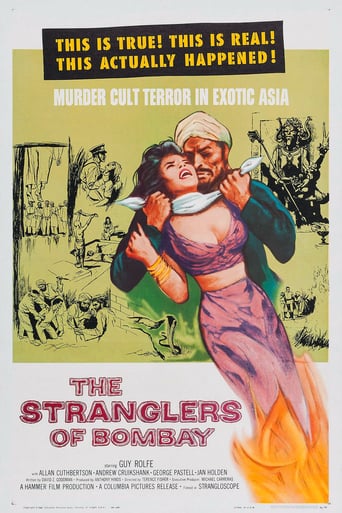NekoHomey
Purely Joyful Movie!
Tedfoldol
everything you have heard about this movie is true.
Dynamixor
The performances transcend the film's tropes, grounding it in characters that feel more complete than this subgenre often produces.
GarnettTeenage
The film was still a fun one that will make you laugh and have you leaving the theater feeling like you just stole something valuable and got away with it.
tomgillespie2002
The closing title card of this lesser-known title from Hammer's back catalogue reads "if we have done nothing else for India, we have done this one good thing." Referring to the British East India Company's governance over India for over a hundred years, The Stranglers of Bombay depicts the disappearance of thousands of India's population at the hands of the 'Thugees', an organised gang of murderers and thieves who operated relatively undetected for more than 600 years, and how their operations were eventually brought to an end. It is a subject that would no doubt be handled more delicately if tackled today, and I'm sure that those sensitive to modern PC standards may be somewhat offended by the film, but Stranglers is well-balanced and ultimately apologetic for the Company's occupation, finding a positive note in what was a barbaric time.Captain Harry Lewis (Guy Rolfe) of the East India Company is the only person interested in the reports of over a thousand disappearances, attempting to bring the mystery to the attention of his superiors. However, Colonel Henderson (Andrew Cruickshank) is more concerned with solving the mystery of how English merchants' caravans are similarly disappearing without a trace. To get Lewis off his back, Henderson agrees to an investigation, but opts to hand the reigns to the inexperienced and pompous Captain Connaught-Smith (Allan Cuthbertson). Frustrated at Connaught-Smith's bungling and the general disdain he has for the Indian people, Lewis quits the Company to carry out his own inquiry, and uncovers a murderous cult who make sacrifices in the name of their god, Kali. Led by the High Priest of Kali (George Pastell), the gang's influence goes all the way to the very top, which is how they have managed to remain in the shadows for centuries.The Stranglers of Bombay is low on horror but higher on adventure. The violence is implied rather than shown, but the film doesn't shy away from their grotesque acts. Eyes and tongues are removed, but most are garrotted with a ceremonial silk scarf. It's off-camera, but nevertheless effective. When the action is away from the thugees, the story plays out more like a period detective thriller, as Lewis plunges himself deeper into this secret world while the population denies the group's very existence. It's no surprise then to learn that frequent Hammer collaborator Terence Fisher is behind the camera, who would always shoot efficiently and make his films appear more expensive than they actually were. The absence of Christopher Lee and Peter Cushing is almost always felt when watching a Hammer horror, but leading man Guy Rolfe proves to be a perfectly watchable leading man, earning our sympathy as the one decent white man in a company of incompetent and uncaring fellow officers. While more attention could have been given to the suffering of the Indian people, the film's heart is certainly in the right place, making it one of Hammer's most interesting, while not their most thrilling, entries into the genre.
Scott LeBrun
In 19th Century India, a vicious cult dubbed the Thuggees is terrorizing their own countrymen, robbing and killing with impunity. Harry Lewis (Guy Rolfe), a captain with the East India Company, knows that there's a problem. He's noted the mass disappearances of citizens over time, but his superior officer (Andrew Cruickshank) doesn't take him seriously. Harry gets personally involved when his faithful servant, Ram Das (Tutte Lemkow), goes missing while in search of his brother.Hammer stalwart Terence Fisher directs with his customary efficiency. Fisher keeps the entertaining story moving along nicely, taking advantage of the exotic setting and creating some truly wonderful atmosphere. Many of the popular Hammer talents strut their stuff, including the cinematographer, Arthur Grant, who shoots "The Stranglers of Bombay" in beautiful widescreen black & white. Bernard Robinson also works wonders with the production design. Written by David Zelag Goodman ("Straw Dogs", "Logan's Run", "Eyes of Laura Mars"), this is a reasonably absorbing adventure. Some viewers might take offence at the portrayal of the Thuggee cult (just as people did when "Indiana Jones and the Temple of Doom" came along 25 years later). But the suspense is undeniable at times and it's cute to see a mongoose play a part in the action when Lewis's life is threatened by a cobra. It's a truly chilling moment when Ram Das is murdered in cold blood by someone close to him.Excellent performances are a real plus. Rolfe is a highly engaging hero, and among the other Hammer repertory players here, George Pastell shines. Pastell has one of his most substantial roles as the villainous High Priest of Kali. Allan Cuthbertson is amusing as the arrogant, ineffective Captain Connaught-Smith. Marne Maitland, Paul Stassino, Roger Delgado, John Harvey, Warren Mitchell, Michael Nightingale, Ewen Solon, and David Spenser all do fine jobs in their respective roles.Some viewers may also be put off by the rather vivid violence, but this film still sizes up as an agreeable diversion for Hammer fans.Seven out of 10.
Spikeopath
The Stranglers of Bombay is out of Hammer Film Productions. It's directed by Terence Fisher and written by David Zelag Goodman. It stars Guy Rolfe, Jan Holden, Andrew Cruickshank, George Pastell, Marne Maitland and Paul Stassino. Music is by James Bernard and cinematography by Arthur Grant.For hundreds of years there existed in India a perverted religious sect, dedicated to the wanton destruction of human life....So secret was this savage cult that even the British East Indian Company, rulers of the country at the time, was unaware of their existence....So it begins, a compact and often violent retelling of the Thuggee Cult in India in the 1820s. It was considered strong stuff back on release and had the head suits at the BBFC shifting uneasily in their office chairs. It's a film that has also fallen unfairly into the realm where political correctness dwells, where some folk are seemingly obsessed with decrying old movies for their outdated political portrayals. This deserves better, for it's a very good script, where although the history is difficult to pin down as being correct, it does at least show a care and attention to detail where the Thugee Cult is concerned.It's also a good old adventure yarn, full of intrigue, peril and detective work. Fisher directs at a clip, never allowing the plot to stagnate, and the low budget afforded the project is barely evident amongst some very effective sets. Cast are mostly good value for money, with lead players Rolfe perfectly restrained as an officer desperately trying to be heard and Pastell owning the film as the High Priest of Kali; in fact he is revelling in the bad guy role. Bernard provides an ear banging effective musical accompaniment.Torture, maiming, heroics and a clever mongoose, something for everyone here! 7/10
bkoganbing
If the British did accomplish one good thing in India it was getting rid of the strangling cult Thugee. It took years to eradicate them and there are some who would say they've not been completely eradicated. But if India had been another planet and the British were operating under the Prime Directive it would have made for some interesting history.As it was this particular film, The Stranglers Of Bombay takes place in the early part of the 18th century when India was ruled not by the crown directly, but through the British East India Company. The soldiers you see report to them in London and the idea of course is take care of whatever is slowing down company profits.Guy Rolfe who has played some really nasty villains in such films as Ivanhoe, Taras Bulba, and King Of The Khyber Rifles is a time serving captain in their army who has spent twenty years in India and is rather steeped in their culture. He's the right man for finding out what's at the bottom of a lot of mysterious disappearances, but Colonel Andrew Cruickshank selects the arrogant and fatuous Allan Cuthbertson, newly arrived in India for the job. Kind of dumb, but if he had given Rolfe a free hand we wouldn't have had much of a film.Classic movie fans recall Eduardo Ciannelli as the Guru of the Thugs in Gunga Din who had some really ambitious goals for followers. The head of the cult here is far more local and a man not quite of Ciannelli's vision of eradicating the British and sweeping the world for Kali.There were some plot holes in the script or otherwise I would have given The Stranglers Of Bombay a higher rating. Still it was an unusual subject for Hammer films, no unworldly demons or monsters to deal with, just some very human villainy.

